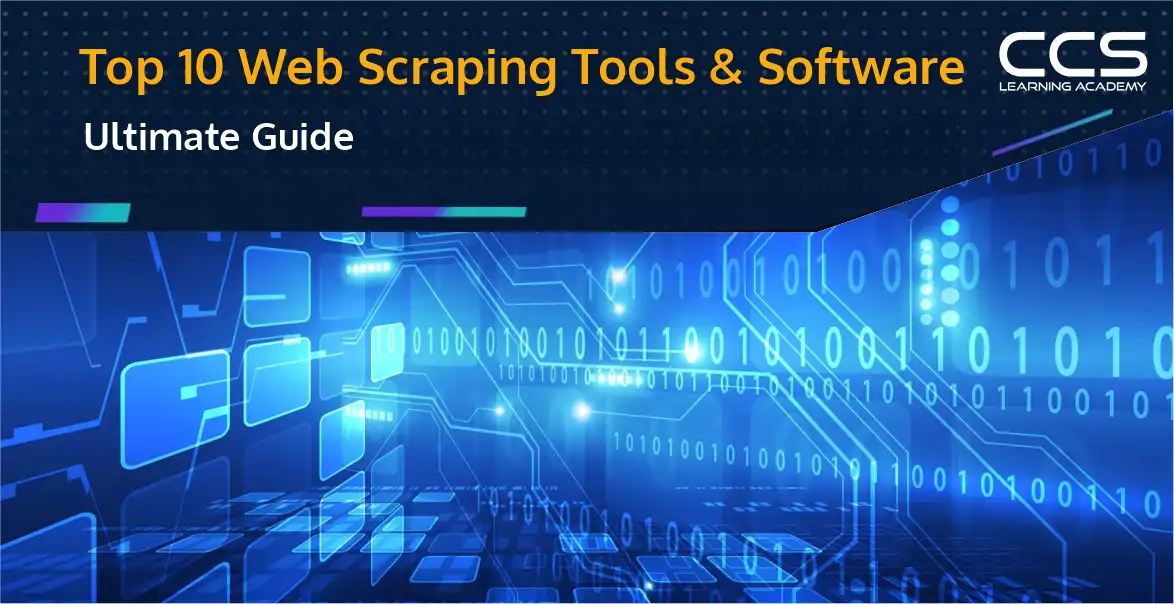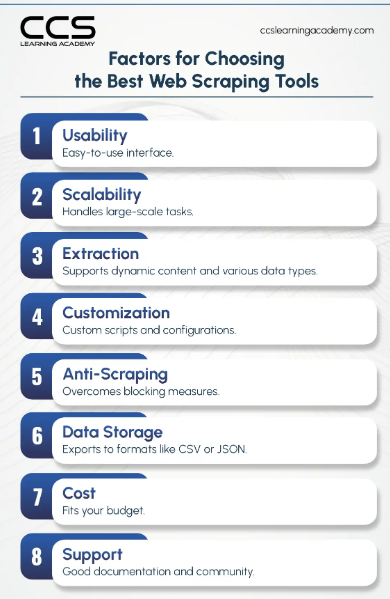Top 10 Web Scraping Tools & Software for 2025 [Ultimate Guide]
- -
- Time -

I once met a friend, Alex, who ran a small e-commerce business. He had a simple problem—he wanted to keep track of his competitors’ prices and adjust his own to stay competitive. Every morning, he would visit multiple websites, jot down prices in a spreadsheet, and update them manually. It took hours.
One day, I asked, “Why don’t you automate this?”
“How?” he asked, puzzled.
That’s when I introduced him to web scraping—a powerful way to extract data from websites automatically. Instead of manually gathering data, web scraping tools collect, organize, and update information in real time. Within a few weeks, Alex was using a web scraping tool that pulled competitor prices directly into his database, saving him hours of work. His business was now smarter, faster, and more competitive.
Just like Alex, many businesses rely on web scraping tools to collect market insights, monitor trends, and generate leads. In this guide, we’ll explore why web scraping is important, how it works, and the top 10 tools to help you automate data collection in 2025.
Importance of Using Web Scraping Tools
Think about the amount of data available online—pricing information, product details, market trends, and customer reviews. Manually collecting this data is nearly impossible. That’s why businesses use web scraping tools to:
- Save time – Automate repetitive data collection.
- Stay ahead of competitors – Track competitor pricing and strategies.
- Make data-driven decisions – Gather market trends and insights.
- Improve lead generation – Extract potential customer details.
- Reduce costs – Avoid hiring extra staff for manual data collection.
From e-commerce to finance, marketing to research, web scraping helps businesses of all sizes make better decisions. If you or your team want a training program, you can join CCSLA’s Snowflake Data Engineer Training program.
Now, let’s look at the top 10 web scraping tools that can help you extract valuable insights effortlessly.
Read more: What is Data Wrangling? Definition, Tools, and Benefits.
List of Top 10 Web Scraping Tools & Software for 2025
Choosing the best one is important as your valuable decisions will be based on such tools. Always look for the tool that suits your requirements when evaluating multiple options. Some web scraper tools are more compatible with monitoring specific data types than others.

Here is the list of the top 10 web scraping tool & softwares for 2025:
1. Webscraper.io
This software is designed to extract data and automate parallel tasks. It offers webhook and API access for its users. The IP rotation through IP addresses is also very effective in this software.
It provides robust reliability and adaptability for your varied requirements. Furthermore, Webscraper-io seamlessly integrates with Dropbox, Google Sheets, and Amazon S3.
Key features:
- Extracts data from dynamic websites.
- Enhance the efficiency of data post-processing.
- Uses Javascript sites for full execution of projects.
- Allows customization of data with valid and preferable sitemaps.
- Enables exportation of data in XLSX, JSON, and CSV formats.
Most suitable for:
Webscraper.io has a robust ability to demonstrate the process of extracting data and automating parallel tasks in just 20 minutes. You can use this tool if you need a speedy scraper tool under a budget of $50 to $300.
2. Bright Data
Bright Data is a web scraping tool designed by developers with unblocking proxy infrastructure. It has a fully hosted IDE with ready-made scraping functions.
It reduces development time and ensures a limitless scale to retrieve crucial public web data. A well-thought API provides flexibility and reliability that helps you make informed decisions.
Key features:
- Has a fully hosted cloud environment.
- Leverages the industry’s robust proxy infrastructure.
- Browser equipped with JavaScript.
- Built-in Proxy & unblocking feature.
- Industry-leading compliance.
- Pre-made web scraping templates.
Most suitable for:
Bright data is a big achievement for the e-commerce world. It refines companies’ product and pricing strategies by gathering insights from multiple sources like social media and trending sites.
Read more: What is Data Extraction? Examples, Tools & Techniques.
3. Apify
One of the most versatile tools that allows you to build custom scripts for data extraction. Apify is a web scraping tool highlighting features like cloud execution, integration, and scheduling.
This tool is available in both a paid version and a free trial. Many web scrapers use Apify to integrate into their workflow management. It is a no-code strong web scraping and automation tool that also facilitates third-party extraction with excellent customer support features.
Key features:
- No-code and open-source proxy management.
- Search engine crawler.
- Browser extension facility.
- Hundreds of ready-to-use templates.
- Proxy API.
Most suitable for:
Apify has a forever-free plan starting at just $49. So, if you need a one-click web scraping process by integrating web pages, mobile applications, and e-commerce platforms, use Apify to automate your organizational workflow.
4. ParseHub
The ParseHub is a free web scraping tool for extracting online data from multiple resources. This tool comes with a downloadable desktop app equipped with advanced features.
You can scrape and download images or files in any format, such as CSV and JSON. ParseHub is a free and open-source platform popular among freelancers and startup companies. The best part of this tool is that it has no dependency on coding. It facilitates the Rest API feature, which you can use to save or store your extracted data in Excel.
Key features:
- Offers IP rotation.
- Regular expressions are given to clean text and HTML before it starts downloading data.
- API & webhooks are used for integrations.
- Rest API features are there.
- JSON and Excel types of formats are available to download.
- Get data from tables and maps.
- Infinitely scrolling of pages is facilitated.
- Get data behind log-ins.
- Scheduled collection.
- Cloud-based storage facility.
Most suitable for:
ParseHub is ideal for developers, consultants, business analysts, data journalists, and marketing professionals. The price range of this tool starts from $189 per month, which is relatively higher than any other web scraping tool.
5. Diffbot
Diffbot is a trendy tool for the web scraping process. It uses artificial intelligence and machine learning techniques to extract data from multiple sources online. This cloud-based platform is available on the web, iOS, and Android.
Diffbot transforms the collected raw data from the site into organized, contextual, and structured data. Various unique features of Diffbot contribute to the advancement of data extraction using pipeline management. Its features include lead verification, RFX management, and a supplier web portal.
Key features:
- Offers product API.
- Structured search Visual processing facilities.
- Enables scraping of data from non-english web pages.
- JSON or CSV file format.
- Clean text and HTML.
- Custom crawling controls.
- Fully hosted SaaS.
- Articles, discussion, video, image, or product extraction APIs.
Most suitable for:
Diffbot is best for you if you want extra features at a cost-effective price for your business. It is ideal for marketing teams, and market research, outreach, decision-making, lead generation, etc., are some purposes for which it is used.
Read more: How to Start a Career in Data Analytics [Step-by-Step Guide].
6. Scrape.do
Scrape.do is an easy-to-use web scraping tool that offers scalable and fast proxy web scraper API. This cost-effective tool does not charge extra for Google or any other browser.
It provides an average speed of 2 to 3 seconds to collect data from Instagram or any other sources, with a 99% success rate. It also offers residential and mobile proxies at a much cheaper rate.
Key features:
- Rotating proxies are available.
- Rotates every request made to API using the proxy network.
- Fully customizable.
- Unlimited bandwidth for all plans.
- Geotargeting options for more than ten countries.
- JavaScript for web pages.
- Super proxy parameters for protections against data center IP addresses.
Most suitable for:
Scrape.do comes at a low-cost subscription starting at just $29 per month. Its pro plan is also very affordable at $99 monthly for 13 lakh API calls. Anyone who needs to extract data from multiple websites for large-scale projects at low cost can use this tool.
7. ScrapingBee
Another popular web scraping tool is ScrapingBee. It renders web extraction like a real browser and enables the management of multiple sites. This tool uses the latest Chrome extension for fast extraction with proxy providers.
This open-source platform uses JavaScript to scrape data and support all the Java library files. It has user-friendly features like customer support chat and AI bots for good response time.
Key features:
- JavaScript rendering.
- Proxies with rotating IP.
- General web scraping tasks.
- Price monitoring, real estate scraping, and extracting reviews without getting blocked.
- Scraping search engine result pages.
- Growth hacking supports lead generation or social media leads.
Most suitable for:
ScrapingBee is best for one who needs lead generation. Freelancers, small business owners, and startups use this tool at just $49 per month.
8. Import.io
Import.io is a web scraping tool that helps users collect data on a large scale. It provides operational functioning with better accuracy, reliability, and completeness. This tool offers a builder that allows you to establish your datasets by importing data from different web pages and then exporting it to the CSV.
You can make over 1000 APIs with this software on Mac OS, Linux, and Windows. The tool also alerts you at different stages and uses API to easily create a dashboard and monitor various other functions.
Key features:
- Fully customizable options.
- JavaScript-based templates.
- Over 40 million IPs.
- 12+ geolocations.
- Unlimited bandwidth with speeds up to 100Mbps.
- IP rotation.
Most suitable for:
Import.io is best for investment research, machine learning, price monitoring, and building strategies. Various retailers, e-commerce businesses, researchers, and especially startups use this web scraping tool.
9. Grepsr
This tool is developed to produce data scraping solutions for businesses. It can help by providing lead generation, competitor’s pricing strategy, and news aggregation.
Financial data collection allows stakeholders to make meaningful decisions. Thus, tools like Grepsr are necessary to extract reliable and robust data.
Key features:
- Lead generation data.
- Financial & market data.
- Distribution chain monitoring.
- Any custom data requirement.
- API ready.
- Social media data.
- Pricing & competitive data.
Most suitable for:
Grepsr is suited for all small, medium, and large businesses, offering various solutions that fit their business requirements. Though the tool has a little expensive subscription, it is worth trying for a better web scraping experience.
Read more: How to Build a Data Analytics Portfolio and Get Hired [Success Tips]
10. HasData
A web scraping tool with amazing features and unlimited bandwidth. HasData is one of the most popular tools that allows users to extract data from different websites with just a simple API request. No proxy is required here for API calls.
Furthermore, this tool offers ready-made no-code scrapers that enhance users’ experience retrieving data and saving in formats like CSV, Excel, and JSON.
Key features:
- JavaScript is available.
- Automated proxy rotation.
- Worldwide geotargeting.
- Unlimited bandwidth.
- Google SERP API.
Most suitable for:
People who do not have much programming skills or don’t know how to write their scripts from scratch can use this HasData tool with a 30-day free trial.
The Last Say
A web scraping tool unlocks the vast potential of web data. It transforms the raw error-filled data into actionable insights for your business or projects. This tool eases users’ workload and assists professionals in the operations of high-quality content and refined insights.
You must choose the right web scraping tool for your requirements, as handling data is a significant task. Consider the ethical implications and prioritize responsible practices before leveraging the benefit of these tools.
Furthermore, to learn how to handle and engineer vast amounts of data, try out the CCSLA’s Data Analytics & Engineering Bootcamp and get a certificate in 12 weeks. With this bootcamp program, you will better understand data analytics and its related fields under live instructor training and one-to-one mentorship.
FAQ
A: In 2025, the top features to look for in web scraping tools include ease of use, scalability for handling large data sets, support for dynamic content (JavaScript), advanced anti-scraping bypass techniques, customizable scraping configurations, and integration with various data storage formats like CSV, JSON, or databases.
A: Open-source tools are great for small projects or developers with coding experience, as they offer flexibility and no licensing fees (e.g., Scrapy, BeautifulSoup). Paid tools, however, provide additional features like user-friendly interfaces, customer support, and scalability, which are ideal for businesses or large-scale scraping (e.g., Octoparse, ParseHub).
A: Yes, some web scraping tools are designed to handle dynamic websites that rely on JavaScript to load content. Tools like Selenium and Scrapy with Splash are well-suited for scraping JavaScript-heavy sites, as they can simulate browser behavior and capture dynamic content.
A: Data extraction accuracy is crucial, especially when scraping complex websites. Choose tools that support advanced data parsing methods, like XPath or CSS selectors, and have features to handle edge cases like hidden content or CAPTCHA protection, ensuring clean, precise data extraction.
A: Some web scraping tools come with built-in features to bypass anti-scraping mechanisms. For example, tools like Scrapy, Selenium, and Zyte (formerly Crawlera) offer solutions to manage IP rotation, CAPTCHA solving, and other techniques to evade detection and maintain successful scraping operations.
A: Look for tools that allow you to define specific scraping patterns and output formats. Tools like Octoparse and ParseHub offer features like built-in data cleaning and transformation options to organize raw data into structured formats like CSV or JSON, minimizing post-processing effort.
A: For beginners, tools with user-friendly interfaces and minimal coding requirements are ideal. Tools like Octoparse and ParseHub are perfect for non-technical users, offering point-and-click interfaces and templates to simplify the scraping process.
A: For large-scale projects, choose tools that support distributed scraping, manage high volumes of data, and offer automation features. Scrapy, Zyte, and Content Grabber are ideal for high-volume scraping, providing scalability and efficiency through advanced features like task scheduling, multi-threading, and cloud integration.
A: Yes, tools like Scrapy, Octoparse, and Content Grabber allow users to schedule scraping tasks at regular intervals, automate the scraping process, and run multiple tasks concurrently. These features are especially useful for continuous data collection from websites that frequently update their content.
A: To ensure compliance, choose tools that emphasize ethical scraping practices, such as respecting website terms of service, managing request rates to avoid overloading servers, and using IP rotation to prevent detection. Always review local laws and website terms before scraping to avoid legal issues.






